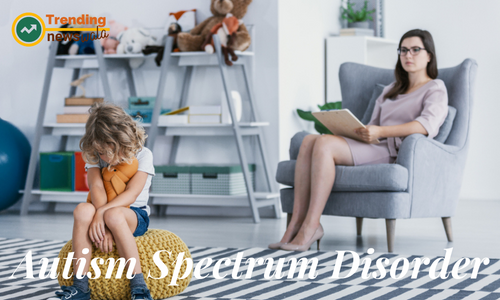Reason and Treatment of Autism Spectrum Disorder

Autism Spectrum Disorder (ASD) is a neurodevelopmental disorder that affects communication, social interaction, and behavior. It is a complex disorder, and the severity of symptoms can vary widely among individuals. Some people with ASD have significant challenges with daily living skills and need ongoing support, while others may be able to live independently.
The symptoms of ASD typically emerge in early childhood, and diagnosis is usually made by the age of two or three years old. Some common signs of ASD include delayed language development, difficulty with social interactions, repetitive behaviors or routines, and heightened sensitivity to sensory input.
The exact causes of ASD are not fully understood, but research suggests that a combination of genetic and environmental factors may be involved. There is no single cause of autism, and scientists are still working to understand the complex interplay of factors that contribute to the development of ASD.
While there is currently no cure for ASD, there are several evidence-based treatments and interventions that can help individuals with ASD improve their quality of life. Some of these interventions include behavioral therapies, speech and language therapy, and medication for associated conditions such as anxiety or ADHD.
It's important to note that people with ASD have unique strengths and abilities, and with the right support and resources, they can achieve their full potential. Many individuals with ASD are highly intelligent and creative, and with the right accommodations and support, they can thrive in a variety of settings.
Overall, ASD is a complex disorder that requires ongoing support and understanding from families, educators, and healthcare professionals. With early diagnosis and intervention, individuals with ASD can lead fulfilling and meaningful lives.
Reasons for Autism Spectrum disorder
Some of the factors that may contribute to the development of ASD include:
- Genetic factors: Research suggests that genetic factors play a significant role in the development of ASD. Studies have shown that individuals with ASD are more likely to have a family history of the disorder, and researchers have identified several genes that may be involved in the development of ASD.
- Environmental factors: Environmental factors, such as prenatal exposure to toxins or infections, have also been linked to an increased risk of ASD. Research suggests that exposure to certain chemicals or infections during pregnancy may interfere with brain development and increase the risk of ASD.
- Neurological factors: Researchers have also identified differences in brain structure and function in individuals with ASD. Some studies have suggested that these differences may be related to abnormal development or connectivity of certain brain regions.
- Immune system dysfunction: Researchers have also identified an association between immune system dysfunction and ASD. Some studies have suggested that abnormalities in the immune system may contribute to the development of ASD.
Overall, ASD is a complex condition that is likely caused by a combination of genetic, environmental, and neurological factors. While research is ongoing, it is clear that early diagnosis and intervention can make a significant difference in the lives of individuals with ASD. By providing appropriate support and resources, individuals with ASD can lead fulfilling and meaningful lives.
Symptoms of Autism
Autism Spectrum Disorder (ASD) is a complex condition that affects individuals in different ways. While the severity of symptoms can vary widely, there are some common signs and symptoms that may indicate the presence of ASD. Here are some of the common symptoms of autism:
- Communication difficulties: Individuals with ASD may have difficulty with verbal and nonverbal communication. They may have difficulty starting or maintaining conversations, may have limited or repetitive speech, and may not understand social cues or body language.
- Social difficulties: People with ASD may struggle with social interactions and relationships. They may have difficulty making friends, may not understand social norms, and may have difficulty understanding other people's perspectives.
- Repetitive behaviors or routines: Individuals with ASD may engage in repetitive behaviors, routines, or interests. They may have difficulty with change or transitions and may become upset or anxious if their routines are disrupted.
- Sensory sensitivities: Many individuals with ASD are highly sensitive to sensory input, such as light, sound, or touch. They may become overwhelmed or agitated in environments with bright lights, loud noises, or strong smells.
- Delayed development: Some individuals with ASD may have delayed development in areas such as language, motor skills, or cognitive skills.
It's important to note that not all individuals with ASD will display all of these symptoms, and the severity of symptoms can vary widely among individuals. Additionally, some of these symptoms may also be present in individuals without ASD, so a diagnosis should always be made by a qualified healthcare professional.
Risk factors and Complications
There are several risk factors associated with Autism Spectrum Disorder (ASD) and potential complications that can arise from the disorder. Here are some of the most common:
Risk factors:
- Genetics: Individuals with a family history of ASD are at a higher risk of developing the disorder.
- Age: Children born to older parents may be at a higher risk of developing ASD.
- Prenatal factors: Exposure to certain toxins, medications, or infections during pregnancy may increase the risk of ASD.
- Sex: ASD is more common in males than females.
Complications:
- Difficulty with social interactions and relationships: Individuals with ASD may have difficulty forming and maintaining relationships, which can lead to social isolation and difficulty in school or work settings.
- Communication difficulties: Difficulty with verbal and nonverbal communication can make it difficult for individuals with ASD to express themselves, understand others, and form connections with others.
- Behavioral issues: Repetitive behaviors and routines, as well as difficulty with change or transitions, can cause difficulty in social, academic, and work settings.
- Sensory sensitivities: Hypersensitivity to certain stimuli, such as loud noises or bright lights, can lead to anxiety and difficulty in everyday activities.
- Co-occurring conditions: Individuals with ASD are at an increased risk of developing co-occurring conditions, such as anxiety, depression, ADHD, and epilepsy.
It's important to note that while ASD can present significant challenges, early diagnosis and intervention can make a significant difference in the lives of individuals with the disorder. By providing appropriate support and resources, individuals with ASD can lead fulfilling and meaningful lives.
Treatment of Autism Spectrum Disorder
The treatment of Autism Spectrum Disorder (ASD) involves a multidisciplinary approach that includes a range of interventions and therapies tailored to the individual needs of each person with the disorder. There is currently no cure for ASD, but early intervention and ongoing support can help individuals with ASD achieve their full potential and lead fulfilling and meaningful lives.
Here are some of the most common treatments for ASD:
- Behavioral therapies: Behavioral therapies, such as Applied Behavior Analysis (ABA), can help individuals with ASD develop communication, social, and self-care skills.
- Speech therapy: Speech therapy can help individuals with ASD improve their communication skills, including speech, language, and social communication.
- Occupational therapy: Occupational therapy can help individuals with ASD develop daily living skills, such as dressing, grooming, and feeding, and improve their sensory processing and motor skills.
- Medication: Medications may be used to manage specific symptoms of ASD, such as anxiety or hyperactivity.
- Educational interventions: Educational interventions, such as specialized schooling or classroom accommodations, can help individuals with ASD achieve academic success.
- Family support and counseling: Family support and counseling can help families of individuals with ASD cope with the challenges of the disorder and develop strategies for supporting their loved ones.
It's important to note that the specific treatment approach will depend on the individual needs of each person with ASD. The goal of treatment is to help individuals with ASD achieve their full potential and lead fulfilling and meaningful lives. With the right support and resources, individuals with ASD can thrive and reach their full potential.
Behavior therapy
Behavior therapy typically involves a range of techniques that are tailored to the specific needs and abilities of each individual with ASD. Some common techniques used in behavior therapy include:
- Positive reinforcement: Positive reinforcement involves rewarding desired behaviors with praise, attention, or other types of reinforcement, such as toys or treats. This can help individuals with ASD learn new skills and behaviors.
- Prompting and shaping: Prompting and shaping involves providing cues or prompts to guide individuals with ASD toward desired behaviors. As the individual becomes more proficient in the behavior, the prompts are gradually faded out.
- Modeling: Modeling involves demonstrating the desired behavior to the individual with ASD. This can help the individual learn new behaviors and skills by observing others.
- Social stories: Social stories are short narratives that describe a specific situation or behavior in a way that the individual with ASD can understand. Social stories can help individuals with ASD understand social situations and expectations.
Behavior therapy is typically conducted in a one-on-one setting with a trained therapist or applied behavior analyst. The therapist works with the individual with ASD to identify specific goals and develop a treatment plan that is tailored to the individual's needs and abilities. Behavior therapy can be a highly effective approach to treating ASD, particularly when it is combined with other therapies and interventions.





